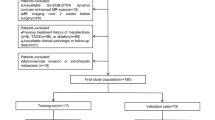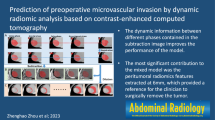Abstract
Microvascular invasion (mVI) is the most significant independent predictor of recurrence for hepatocellular carcinoma (HCC), but its pre-operative assessment is challenging. In this study, we investigate the use of multi-parametric MRI radiomics to predict mVI status before surgery. We retrospectively collected pre-operative multi-parametric liver MRI scans for 99 patients who were diagnosed with HCC. These patients received surgery and pathology-confirmed diagnosis of mVI. We extracted radiomics features from manually segmented HCC regions and built machine learning classifiers to predict mVI status. We compared the performance of such classifiers when built on five MRI sequences used both individually and combined. We investigated the effects of using features extracted from the tumor region only, the peritumoral marginal region only, and the combination of the two. We used the area under the receiver operating characteristic curve (AUC) and accuracy as performance metrics. By combining features extracted from multiple MRI sequences, AUCs are 86.69%, 84.62%, and 84.19% when features are extracted from the tumor only, the peritumoral region only, and the combination of the two, respectively. For tumor-extracted features, the T2 sequence (AUC = 80.84%) and portal venous sequence (AUC = 79.22%) outperform other MRI sequences in single-sequence-based models and their combination yields the highest AUC of 86.69% for mVI status prediction. Our results show promise in predicting mVI from pre-operative liver MRI scans and indicate that information from multi-parametric MRI sequences is complementary in identifying mVI.



Similar content being viewed by others
Notes
https://pyradiomics.readthedocs.io/en/latest/features.html, last accessed Jan. 7th, 2019
References
Bray F, Ferlay J, Soerjomataram I, Siegel RL, Torre LA, Jemal A. Global cancer statistics 2018: GLOBOCAN estimates of incidence and mortality worldwide for 36 cancers in 185 countries. CA Cancer J Clin. 2018. https://doi.org/10.3322/caac.21492
Petrick JL, Braunlin M, Laversanne M, Valery PC, Bray F, Mcglynn KA. International trends in liver cancer incidence, overall and by histologic subtype, 1978-2007. UICC Int J Cancer IJC. 2016;139:1534–1545. https://doi.org/10.1002/ijc.30211
Petrick JL, Kelly SP, Altekruse SF, McGlynn KA, Rosenberg PS. Future of hepatocellular carcinoma incidence in the United States forecast through 2030. J Clin Oncol. 2016;34(15):1787–1794. https://doi.org/10.1200/JCO.2015.64.7412
Altekruse SF, McGlynn KA, Reichman ME. Hepatocellular carcinoma incidence, mortality, and survival trends in the United States from 1975 to 2005. J Clin Oncol. 2009;27(9):1485–1491. https://doi.org/10.1200/JCO.2008.20.7753
Greten TF, Papendorf F, Bleck JS, et al. Survival rate in patients with hepatocellular carcinoma: a retrospective analysis of 389 patients. Br J Cancer. 2005;92(10):1862–1868. https://doi.org/10.1038/sj.bjc.6602590
Forner A, Llovet JM, Bruix J. Hepatocellular carcinoma. Lancet. 2012;379(9822):1245–1255. https://doi.org/10.1016/S0140-6736(11)61347-0
Llovet J, Brú C, Bruix J. Prognosis of hepatocellular carcinoma: the BCLC staging classification. Semin Liver Dis. 1999;19(03):329–338. https://doi.org/10.1055/s-2007-1007122
Marrero JA, Kulik LM, Sirlin CB, et al. Diagnosis, staging, and management of hepatocellular carcinoma: 2018 Practice Guidance by the American Association for the Study of Liver Diseases. Hepatology. 2018;68(2):723–750. https://doi.org/10.1002/hep.29913
Mazzaferro V, Regalia E, Doci R, et al. Liver transplantation for the treatment of small hepatocellular carcinomas in patients with cirrhosis. N Engl J Med. 1996;334(11):693–700. https://doi.org/10.1056/NEJM199603143341104
Tabrizian P, Jibara G, Shrager B, Schwartz M, Roayaie S. Recurrence of hepatocellular cancer after resection: patterns, treatments, and prognosis. Ann Surg. 2015;261(5):947–955. https://doi.org/10.1097/SLA.0000000000000710
Halazun KJ, Najjar M, Abdelmessih RM, et al. Recurrence after liver transplantation for hepatocellular carcinoma. Ann Surg. 2017;265(3):557–564. https://doi.org/10.1097/SLA.0000000000001966
Escartin A, Sapisochin G, Bilbao I, et al. Recurrence of hepatocellular carcinoma after liver transplantation. Transplant Proc. 2007;39(7):2308–2310. https://doi.org/10.1016/J.TRANSPROCEED.2007.06.042
Mazzaferro V, Llovet JM, Miceli R, et al. Predicting survival after liver transplantation in patients with hepatocellular carcinoma beyond the Milan criteria: a retrospective, exploratory analysis. Lancet Oncol. 2009;10(1):35–43. https://doi.org/10.1016/S1470-2045(08)70284-5
Pawlik TM, Gleisner AL, Anders RA, Assumpcao L, Maley W, Choti MA. Preoperative assessment of hepatocellular carcinoma tumor grade using needle biopsy: implications for transplant eligibility. Ann Surg. 2007;245(3):435–442. https://doi.org/10.1097/01.sla.0000250420.73854.ad
Sterling RK, Wright EC, Morgan TR, et al. Frequency of elevated hepatocellular carcinoma (HCC) biomarkers in patients with advanced hepatitis C. Am J Gastroenterol. 2012;107(1):64–74. https://doi.org/10.1038/ajg.2011.312
Gupta S, Bent S, Kohlwes J. Test characteristics of α-fetoprotein for detecting hepatocellular carcinoma in patients with hepatitis C: a systematic review and critical analysis. Ann Intern Med. 2003;139(1):46–50. http://annals.org/aim/fullarticle/716520. Accessed Dec 4, 2018.
Pawlik TM, Delman KA, Vauthey JN, et al. Tumor size predicts vascular invasion and histologic grade: implications for selection of surgical treatment for hepatocellular carcinoma. Liver Transplant. 2005;11(9):1086–1092. https://doi.org/10.1002/lt.20472
Roayaie S, Frischer JS, Emre SH, et al. Long-term results with multimodal adjuvant therapy and liver transplantation for the treatment of hepatocellular carcinomas larger than 5 centimeters. Ann Surg. 2002;235(4):533–539. http://www.ncbi.nlm.nih.gov/pubmed/11923610. Accessed January 4, 2019.
Ünal E, İdilman İS, Akata D, Özmen MN, Karçaaltıncaba M. Microvascular invasion in hepatocellular carcinoma. Diagnostic Interv Radiol. 2016;22(2):125–132. https://doi.org/10.5152/dir.2015.15125
Renzulli M, Brocchi S, Cucchetti A, et al. Can current preoperative imaging be used to detect microvascular invasion of hepatocellular carcinoma? Radiology. 2016;279(2):432–442. https://doi.org/10.1148/radiol.2015150998
Chou C-T, Chen R-C, Lin W-C, Ko C-J, Chen C-B, Chen Y-L. Prediction of microvascular invasion of hepatocellular carcinoma: preoperative CT and histopathologic correlation. Am J Roentgenol. 2014;203(3):W253–W259. https://doi.org/10.2214/AJR.13.10595
Yang C, Wang H, Sheng R, Ji Y, Rao S, Zeng M. Microvascular invasion in hepatocellular carcinoma: is it predictable with a new, preoperative application of diffusion-weighted imaging? Clin Imaging. 2017;41(2017):101–105. https://doi.org/10.1016/j.clinimag.2016.10.004
Lei Z, Li J, Wu D, et al. Nomogram for preoperative estimation of microvascular invasion risk in hepatitis B virus–related hepatocellular carcinoma within the Milan criteria. JAMA Surg. 2016;151(4):356. https://doi.org/10.1001/jamasurg.2015.4257
Kim H, Park MS, Choi JY, et al. Can microvessel invasion of hepatocellular carcinoma be predicted by pre-operative MRI? Eur Radiol. 2009;19(7):1744–1751. https://doi.org/10.1007/s00330-009-1331-8
Kim KA, Kim M-J, Jeon HM, et al. Prediction of microvascular invasion of hepatocellular carcinoma: usefulness of peritumoral hypointensity seen on gadoxetate disodium-enhanced hepatobiliary phase images. J Magn Reson Imaging. 2012;35:629–634. https://doi.org/10.1002/jmri.22876
Bakr S, Echegaray S, Shah R, Kamaya A, Louie J. Noninvasive radiomics signature based on quantitative analysis of computed tomography images as a surrogate for microvascular invasion in hepatocellular carcinoma: a pilot study. J Med Imaging. 2017;4(04):1. https://doi.org/10.1117/1.JMI.4.4.041303
Li H, Zhang J, Zheng Z, et al. Preoperative histogram analysis of intravoxel incoherent motion (IVIM) for predicting microvascular invasion in patients with single hepatocellular carcinoma. Eur J Radiol. 2018;105(January):65–71. https://doi.org/10.1016/j.ejrad.2018.05.032
Ahn SJ, Kim JH, Park SJ, Kim ST, Han JK. Hepatocellular carcinoma: preoperative gadoxetic acid–enhanced MR imaging can predict early recurrence after curative resection using image features and texture analysis. Abdominal Radiology. http://link.springer.com/10.1007/s00261-018-1768-9. Published September 18, 2018. Accessed Oct 18, 2018.
Feng ST, Jia Y, Liao B, et al. Preoperative prediction of microvascular invasion in hepatocellular cancer: a radiomics model using Gd-EOB-DTPA-enhanced MRI. Eur Radiol. 2019;29(9):4648–4659. https://doi.org/10.1007/s00330-018-5935-8
Sumie S, Nakashima O, Okuda K, et al. The significance of classifying microvascular invasion in patients with hepatocellular carcinoma. Ann Surg Oncol. 2014;21(3):1002–1009. https://doi.org/10.1245/s10434-013-3376-9
Semelka RC, Kelekis NL, Thomasson D, Brown MA, Laub GA. HASTE MR imaging: description of technique and preliminary results in the abdomen. Vol 6.; 1996. https://doi.org/10.1002/jmri.1880060420
Runge VM, Wood ML, Kaufman DM, Kevin Nelson ML, Traill MR. FLASH: clinical three-dimensional magnetic resonance imaging. Vol 8.; 1988. https://pubs.rsna.org/doi/pdf/10.1148/radiographics.8.5.3227132. Accessed Jan 4, 2019.
Rofsky NM, Lee VS, Laub G, et al. Abdominal MR imaging with a volumetric interpolated breath-hold examination. Radiology. 1999;212(3):876–884. https://doi.org/10.1148/radiology.212.3.r99se34876
Roayaie S, Blume IN, Thung SN, et al. A system of classifying microvascular invasion to predict outcome after resection in patients with hepatocellular carcinoma. Gastroenterology. 2009;137(3):850–855. https://doi.org/10.1053/j.gastro.2009.06.003
Van Griethuysen JJM, Fedorov A, Parmar C, et al. Computational radiomics system to decode the radiographic phenotype. Cancer Res. 2017;77(21):e104–e107. https://doi.org/10.1158/0008-5472.CAN-17-0339
Tibshirani R. Regression shrinkage and selection via the lasso: a retrospective. J R Stat Soc Ser B (Statistical Methodol). 2011;73(3):273–282. https://doi.org/10.1111/j.1467-9868.2011.00771.x
Tahmassebi A, Wengert GJ, Helbich TH, et al. Impact of machine learning with multiparametric magnetic resonance imaging of the breast for early prediction of response to neoadjuvant chemotherapy and survival outcomes in breast cancer patients. Invest Radiol. 2019;54(2):110–117. https://doi.org/10.1097/RLI.0000000000000518
Edmondson HA, Steiner PE. Primary carcinoma of the liver.A study of 100 cases among 48,900 necropsies. Cancer. 1954;7(3):462–503. https://doi.org/10.1002/1097-0142(195405)7:3<462::AID-CNCR2820070308>3.0.CO;2-E
Chandarana H, Robinson E, Hajdu CH, Drozhinin L, Babb JS, Taouli B. Microvascular invasion in hepatocellular carcinoma: is it predictable with pretransplant MRI? Am J Roentgenol. 2011;196(5):1083–1089. https://doi.org/10.2214/AJR.10.4720
Funding
This work was supported by National Institutes of Health (NIH)/National Cancer Institute (NCI) grants (#1R01CA193603, #3R01CA193603-03S1, and #1R01CA218405), a Radiological Society of North America (RSNA) Research Scholar Grant (#RSCH1530), an Amazon AWS Machine Learning Research Award, and a University of Pittsburgh Physicians (UPP) Academic Foundation Award.
Author information
Authors and Affiliations
Corresponding authors
Ethics declarations
Conflict of Interest
The authors declare that they have no conflict of interest.
Additional information
Publisher’s Note
Springer Nature remains neutral with regard to jurisdictional claims in published maps and institutional affiliations.
Rights and permissions
About this article
Cite this article
Nebbia, G., Zhang, Q., Arefan, D. et al. Pre-operative Microvascular Invasion Prediction Using Multi-parametric Liver MRI Radiomics. J Digit Imaging 33, 1376–1386 (2020). https://doi.org/10.1007/s10278-020-00353-x
Published:
Issue Date:
DOI: https://doi.org/10.1007/s10278-020-00353-x




